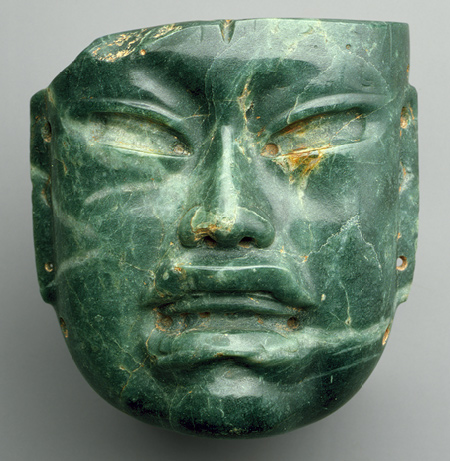”Formative” is a term that is applied to that stage of life in Mexico and Peru when a stable agriculture had been achieved and enabled villages to exist and populations to grow. This occurred between 1500 and 500 B.C. when technically and socially, the great classic civilizations of the Americas were being forged. Five thousand years separate the earliest beginnings of agriculture in Mexico from the Formative stage. The Formative period is perhaps the best known era in Latin American history before the conquest.
The most interesting civilization of this Formative period, and the most controversial, is that of the Olmecs, or ”rubber people”, as the Aztec were to name them centuries later. They must have been an extraordinary people; indeed some think they built the mother civilization of Mexico and Central America. Their art, striking and powerful, consists mainly of stone sculptures, with emphasis on the jaguar and serpent motifs, and on combinations of feline and human elements. Such works of art were found for the most part in three ceremonial centers in southeastern Mexico.
The gigantic stone heads left at La Venta by the Olmecs have been there for all to see for centuries, but it was only in the 1930’s that any serious notice was taken of them. Now, however, the study of this art has led to the conclusion that the Olmecs were the progenitors of civilization in Mexico. Some archaeologists believe that Olmec influences, transported through sea trade, were basic to the great art style of Chavin in northern Peru,
where there was also a jaguar god.
Whether or not the Olmec culture was the basis of the classic civilizations, they were coming into being architecturally and artistically a century or two before the beginning of the Christian era. To the south of them in what is now Guatemala, the Maya were just beginning to build on a large scale. In northern Peru, the Mohica had already developed one of the great pottery styles of ancient America. In central Peru, on the Paracas peninsula, a little known people had developed an art and style of weaving which has few parallels anywhere in the world for fineness and intricacy.
One of the most spectacular archaeological projects is at Teotihuacan, near Mexico City. It has long been famous for its twin pyramids of he ”Sun and the Moon” in addition to sculptures and new frescoes. Teotihuacan appears to have been a true city with a large permanent population and not merely a ceremonial center; without doubt one of the biggest cities of preconquest Mexico and of the entire ancient American world. Tikal, a notable Mayan site in the jungle of the Peten district in northeastern Guatemala, is the largest Maya ruin known, with the largest temples. Five of these rise above the jungle to heights of more than two hundred feet. There is still no definitive answer on whether
Tikal or any of the other Maya sites can properly be termed ”cities” or mere ceremonial centers which housed only the priestly class.
Another subject of controversy among Maya scholars is how to correlate the Maya and Christian calendars. The glyphs they carved on their stelae are often dates; indeed the dates are all that researchers have as yet been able to decipher. By the time the Spaniards arrived in the sixteenth century, the Maya of Yucatan were no longer recording dates in the old way and could give their conquerors only a sketch idea of what the calendrical graphs signified. They could identify a date, but only within a limited cycle of time. While we count time in units of one hundred years, the basic unit of the Maya is about two hundred and sixty years.

Metropolitan:Of the many stone masks known from the ancient Americas, few are as arresting as this example made by the Olmec peoples of southern Mexico. A work of no later than the mid-first millennium B.C., it is carved of hard, semiprecious jadeite worked with amazing subtlety. An elegant straight nose sets off the wide-set eyes, now missing their inlay. In spite of the lifelike details of square jaw, small rounded chin, and puffy eyelids, the mouth defines the mask as other than a realistic depiction.
Though scholars are perfectly able to read the glyphs expressing the date of a day and the name of a month, they are then faced with the choice of placing it in any one of three or four Maya ”centuries”. The only way this problem could be solved was to determine exactly the Christian date of some object which had already been dated by the Maya system. Carbon dating provided a method for doing this, except that nearly all Maya dates are carved in stone and thus cannot be tested.

"The Wrestler", an Olmec era figurine, 1200 - 800 BCE. . Art historian George Kubler finds that "the spiraling motion of the body, the multiplicity of profile, the coherent muscles, and the expressiv
straint of the work set it apart as among the great works of sculpture of all ages"However, at Tikal there are a number of standing temples with large, beautifully carved lintels, some of which are dated. Wood from uncarved beams, assumed to be contemporaneous wit the carved ones, was taken from several temples and underwent a long series of carbon tests. The result was a consistent pattern of dates that indicates which of the Maya centuries is the correct one to choose in correlating the two calendars, thus solving a major problem.









 COMMENTS
COMMENTS